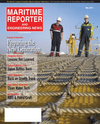
Page 50: of Maritime Reporter Magazine (May 2011)
Training & Education Edition
Read this page in Pdf, Flash or Html5 edition of May 2011 Maritime Reporter Magazine
FEATURE DANISH SHIPOWNERS
Danish shipping is global, with trade within Europe counting for only a quarter of the industry’s total revenues. The pri- mary markets are the US and China, making up more than 15 percent of the revenues. "Here in Denmark the shipping sector is really a success. We are going forward with all the key figures we can find. In Denmark we have passed the fi- nancial crisis and are picking up the new challenges," says Jan Fritz Hansen, Ex- ecutive Vice President at the Danish
Shipowners' Association. "The statement is a little exaggerated as it covers differ- ences in different market segments," he adds. A reason to that Denmark coped relatively well with the crisis was the flexible business model applied by many of the owners, with chartered-in tonnage supplementing the own fleets.
The Danish Shipowners' Association has 21 shipping company members, in- cluding companies like A.P. Moeller-
Maersk, Torm, Norden, J.Lauritzen,
Nordic Tankers and DFDS and 14 asso- ciate members, such as Clipper Group,
Eitzen, Nordic Bulk Carriers, Container
Shipping and Unifeeder, to mention some main companies.
The Danish flag tonnage figures have increased steadily, despite the financial crisis. In April this year, the amount of ships was 585, (compared to 551 at 1
January 2010). The combined gross tonnage is 11,7mGT and combined deadweight 14,4mdwt. The figures for the beginning of 2010 were 10,9mGT and 13,5mdwt respectively, showing an aggressive, around 7% increase during this demanding period. 60 percent of the merchant fleet consists of liners, 35% are tankers and 5% operate in tramp trade. The deadweight of Danish owned foreign flag vessels is some 20mdwt and chartered-in vessels amount to more than 20mdwt, bringing the total fleet under
Danish control to above 55mdwt. The av- erage age of the Danish fleet is 7.6 years, compared to 10.4 years for the world fleet. Under construction are 211 vessels totaling 10mdwt and valued at DKK63b.
The number of newbuilding orders was a record 363 at the beginning of 2009 going down to 273 at the beginning of 2010. The Danish Shipowners Associa- tion believes that a 15% to 25% reduction in CO2 carbon emissions is realistically possible to achieve, up to 2020. Denmark was an initiator to the EEDI energy effi- ciency design index, right now a hot topic within IMO. Many Danish shipowners tell Maritime Reporter how important it is to reach a decision this coming sum- mer on the issue. "I would really like to emphasize, that it is really important that the IMO meeting at the Marine Environ- ment Protection Committee, taking place in July, will hopefully be able to decide on a package of technical measures to ad- dress the CO2 emissions. It is really cru- cial that this package goes thru.
Otherwise we are going to see regional legislations in Europe the outcome we could not longer have an influence on," says Simon Bennett, Director at the In- ternational Chamber of Shipping. Ac- cording to the Danish Shipowners
Association, a design index for climate efficient bulk carriers, tankers and con- tainer vessels is an important and good initiative, whereas it is difficult to set up a general relevant target for ro-ro vessels.
What comes to fighting Greenhouse
Gases, the Danish position is that a spe- cial fund under IMO is a good basis for discussion, as stated in a proposal by
Denmark brought forward on a Market
Based Instrument. The Danish Shipown- ers' Association though states, in its An- nual Report, that "It is important to arrive at a model which is also acceptable for
China and the US, and like the shipping industry, both these countries are focus- ing on reducing emissions by making ships more efficient. Therefore, there is every reason to examine the possibilities of making the contribution to the Fund from the individual ship dependent upon the level of climate-friendliness of the ship." Arne C. Mikkelsen, Counsellor at
Danish Shipowners' Association notes that support for the Green House Gas
Fund proposal has been received lately from the large shipping nations Greece,
Liberia and South Korea. "Emission trad- ing is not supported outside Europe," he said. "Will the industry and the EU unite behind the most probable international solution?" he asks.
Denmark is surrounded by an ECA area, with increasing restrictions on sul- phur emissions. Also nitrogen oxides emissions are being cut. Danish
Shipowners stress that it is vital that the types of oil or treatment equipment de- manded for vessels in the future are avail- able in sufficient quantities and at competitive prices so that there is no shift from sea to land transport. This view is shared by Simon H. Galsgaard, Director at Unifeeder A/S, a shipping company, engaged in a 36 vessel feeder and short- 50 Maritime Reporter & Engineering News
Danish Shipowners Back on the Growth Track
Denmark retained its position as one of the world's leading maritime nations, despite the economic crisis. In terms of operated tonnage, Denmark is today the fifth largest maritime nation in the world. In all, Dan- ish shipping companies trans- port some 10% of the world trade.
Henrik Segercrantz reports. (Photo: Unifeeder)

 49
49

 51
51
